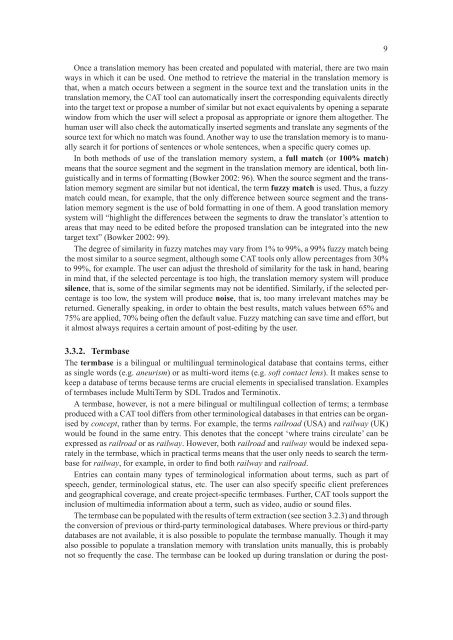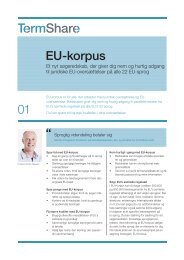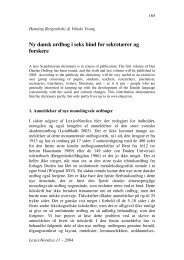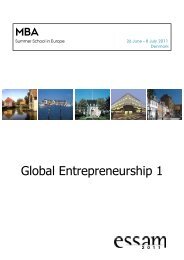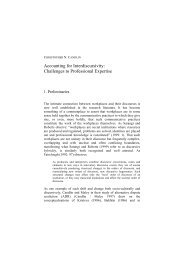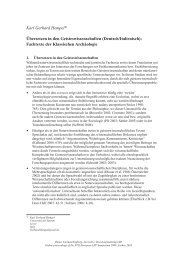The Workflow of Computer-Assisted Translation Tools in
The Workflow of Computer-Assisted Translation Tools in
The Workflow of Computer-Assisted Translation Tools in
You also want an ePaper? Increase the reach of your titles
YUMPU automatically turns print PDFs into web optimized ePapers that Google loves.
Once a translation memory has been created and populated with material, there are two ma<strong>in</strong><br />
ways <strong>in</strong> which it can be used. One method to retrieve the material <strong>in</strong> the translation memory is<br />
that, when a match occurs between a segment <strong>in</strong> the source text and the translation units <strong>in</strong> the<br />
translation memory, the CAT tool can automatically <strong>in</strong>sert the correspond<strong>in</strong>g equivalents directly<br />
<strong>in</strong>to the target text or propose a number <strong>of</strong> similar but not exact equivalents by open<strong>in</strong>g a separate<br />
w<strong>in</strong>dow from which the user will select a proposal as appropriate or ignore them altogether. <strong>The</strong><br />
human user will also check the automatically <strong>in</strong>serted segments and translate any segments <strong>of</strong> the<br />
source text for which no match was found. Another way to use the translation memory is to manually<br />
search it for portions <strong>of</strong> sentences or whole sentences, when a specifi c query comes up.<br />
In both methods <strong>of</strong> use <strong>of</strong> the translation memory system, a full match (or 100% match)<br />
means that the source segment and the segment <strong>in</strong> the translation memory are identical, both l<strong>in</strong>guistically<br />
and <strong>in</strong> terms <strong>of</strong> formatt<strong>in</strong>g (Bowker 2002: 96). When the source segment and the translation<br />
memory segment are similar but not identical, the term fuzzy match is used. Thus, a fuzzy<br />
match could mean, for example, that the only difference between source segment and the translation<br />
memory segment is the use <strong>of</strong> bold formatt<strong>in</strong>g <strong>in</strong> one <strong>of</strong> them. A good translation memory<br />
system will “highlight the differences between the segments to draw the translator’s attention to<br />
areas that may need to be edited before the proposed translation can be <strong>in</strong>tegrated <strong>in</strong>to the new<br />
target text” (Bowker 2002: 99).<br />
<strong>The</strong> degree <strong>of</strong> similarity <strong>in</strong> fuzzy matches may vary from 1% to 99%, a 99% fuzzy match be<strong>in</strong>g<br />
the most similar to a source segment, although some CAT tools only allow percentages from 30%<br />
to 99%, for example. <strong>The</strong> user can adjust the threshold <strong>of</strong> similarity for the task <strong>in</strong> hand, bear<strong>in</strong>g<br />
<strong>in</strong> m<strong>in</strong>d that, if the selected percentage is too high, the translation memory system will produce<br />
silence, that is, some <strong>of</strong> the similar segments may not be identifi ed. Similarly, if the selected percentage<br />
is too low, the system will produce noise, that is, too many irrelevant matches may be<br />
returned. Generally speak<strong>in</strong>g, <strong>in</strong> order to obta<strong>in</strong> the best results, match values between 65% and<br />
75% are applied, 70% be<strong>in</strong>g <strong>of</strong>ten the default value. Fuzzy match<strong>in</strong>g can save time and effort, but<br />
it almost always requires a certa<strong>in</strong> amount <strong>of</strong> post-edit<strong>in</strong>g by the user.<br />
3.3.2. Termbase<br />
<strong>The</strong> termbase is a bil<strong>in</strong>gual or multil<strong>in</strong>gual term<strong>in</strong>ological database that conta<strong>in</strong>s terms, either<br />
as s<strong>in</strong>gle words (e.g. aneurism) or as multi-word items (e.g. s<strong>of</strong>t contact lens). It makes sense to<br />
keep a database <strong>of</strong> terms because terms are crucial elements <strong>in</strong> specialised translation. Examples<br />
<strong>of</strong> termbases <strong>in</strong>clude MultiTerm by SDL Trados and Term<strong>in</strong>otix.<br />
A termbase, however, is not a mere bil<strong>in</strong>gual or multil<strong>in</strong>gual collection <strong>of</strong> terms; a termbase<br />
produced with a CAT tool differs from other term<strong>in</strong>ological databases <strong>in</strong> that entries can be organised<br />
by concept, rather than by terms. For example, the terms railroad (USA) and railway (UK)<br />
would be found <strong>in</strong> the same entry. This denotes that the concept ‘where tra<strong>in</strong>s circulate’ can be<br />
expressed as railroad or as railway. However, both railroad and railway would be <strong>in</strong>dexed separately<br />
<strong>in</strong> the termbase, which <strong>in</strong> practical terms means that the user only needs to search the termbase<br />
for railway, for example, <strong>in</strong> order to fi nd both railway and railroad.<br />
Entries can conta<strong>in</strong> many types <strong>of</strong> term<strong>in</strong>ological <strong>in</strong>formation about terms, such as part <strong>of</strong><br />
speech, gender, term<strong>in</strong>ological status, etc. <strong>The</strong> user can also specify specifi c client preferences<br />
and geographical coverage, and create project-specifi c termbases. Further, CAT tools support the<br />
<strong>in</strong>clusion <strong>of</strong> multimedia <strong>in</strong>formation about a term, such as video, audio or sound fi les.<br />
<strong>The</strong> termbase can be populated with the results <strong>of</strong> term extraction (see section 3.2.3) and through<br />
the conversion <strong>of</strong> previous or third-party term<strong>in</strong>ological databases. Where previous or third-party<br />
databases are not available, it is also possible to populate the termbase manually. Though it may<br />
also possible to populate a translation memory with translation units manually, this is probably<br />
not so frequently the case. <strong>The</strong> termbase can be looked up dur<strong>in</strong>g translation or dur<strong>in</strong>g the post-<br />
9


